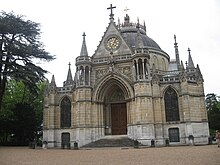Dreux
| Dreux | ||
|---|---|---|

|
|
|
| region | Center-Val de Loire | |
| Department | Eure-et-Loir | |
| Arrondissement | Dreux | |
| Canton |
Dreux-1 (main town) Dreux-2 (main town) |
|
| Community association | Agglo du Pays de Dreux | |
| Coordinates | 48 ° 44 ′ N , 1 ° 22 ′ E | |
| height | 75-139 m | |
| surface | 24.27 km 2 | |
| Residents | 31,044 (January 1, 2017) | |
| Population density | 1,279 inhabitants / km 2 | |
| Post Code | 28100 | |
| INSEE code | 28134 | |
| Website | www.drouais.com | |
 View over the city center of Dreux |
||
Dreux is a municipality with 31,044 inhabitants (as of January 1, 2017) in France in the Eure-et-Loir department .
location
Dreux is located about 90 kilometers west of Paris , in the valley of the river Eure at the confluence of its left tributary Blaise .
history
The city was the capital of a small Gallic tribe, the so-called "Durocasses". In Roman times, important roads crossed here. In the Middle Ages the city was the seat of a county . Various members of the French royal family are buried in the Chapelle Royale Saint Louis.
Battle of Dreux : During the First Huguenot War , on December 19, 1562, the Protestant troops under Prince Ludwig I of Condé and Admiral Gaspard von Coligny were defeated by the Catholic army under François de Lorraine in the Battle of Dreux .
Dreux is the birthplace of François-André Danican Philidor (1726–1795), a composer who is best known today as the strongest chess player of the 18th century.
In the Franco-Prussian War Dreux was captured by Prussian troops on November 19, 1870.
The place received international attention in 1983, when the then insignificant Front National was able to achieve its first major electoral successes and received a majority in the city council; The reasons given were high unemployment in the industrial city and the fear of foreign infiltration due to the arrival of Algerian-Muslim immigrants (especially Harkis from the Algerian war). During the 1990s, contrary to the trend in the rest of the country, the influence of the right-wing extremists was pushed back, so that the party is now represented on the city council with only 2 of 39 council members; in addition, the city made extensive efforts to change its bad reputation. In the 2014 European elections , the FN was the strongest party in Dreux with 24.71%; It also won the first round of the 2015 regional elections in the city with 26.86%, but in the second round had to admit defeat to the candidate of an alliance of various left parties.
Population development
| year | 1962 | 1968 | 1975 | 1982 | 1990 | 1999 | 2006 | 2017 |
| Residents | 21,588 | 29,408 | 33.101 | 33,379 | 35,230 | 31,849 | 32,723 | 31,044 |
| Sources: Cassini and INSEE | ||||||||
Attractions
- Chapelle royale de Dreux or Chapelle royale Saint-Louis
- Ruins of the old fortress
- Saint-Pierre church
- town hall
Twin cities
Dreux is by twinning associated with
- Todi in Umbria (Italy), since 1960
- Melsungen in Hessen (Germany), since 1966
- Koudougou in Burkina Faso , since 1972
- Evesham in Worcestershire, England, since 1977
-
Bautzen in Saxony (Germany), since 1992
A friendship agreement had existed with Bautzen since 1965, which was first signed between the two women's organizations in the town hall of Bautzen in the presence of the then mayor Urban
Sons and daughters
- Antoine Godeau (1605–1672), poet and writer
- Jean Rotrou (1609–1650), dramaturge and poet
- François de Gravelle (around 1645–1708), author and philosopher
- François-André Danican Philidor (1726–1795), composer and famous chess player
- Jean-Louis-Auguste Loiseleur-Deslongchamps (1774–1849), doctor and botanist
- Louis Benoît Guersant (1777–1848), doctor and naturalist (botanist)
- Louis Charles Delescluze (1809–1871), journalist
- Lionel Richard (* 1938), historian, cultural scientist and writer
- Dominique Cravic (* 1946), guitarist
- Jean-Charles Taugourdeau (* 1953), politician
- Catherine Corsini (* 1956), film director
- Laurent Percerou (* 1961), Roman Catholic Bishop of Nantes
- Laurent Dehors (* 1964), jazz musician
- Kalifa Cissé (* 1984), Malian football player
- Yannick Lesourd (* 1988), sprinter
- Adrien Trebel (* 1991), soccer player
- Melissandre Pain (* 1995), track cyclist
Web links
Individual evidence
- ↑ Alex Gardin: La guerre de 1870–1871 à Bernay . Les Éditions Page de Garde, Saint-Aubin-les-Elbeuf 1997, ISBN 2-84340-037-6 , p. 13 (French, first edition: 1898, reprint).
- ^ Opposition councilors on the city's website , accessed June 11, 2016.
- ^ Election results on the website of the French Ministry of the Interior , accessed on June 11, 2016.


